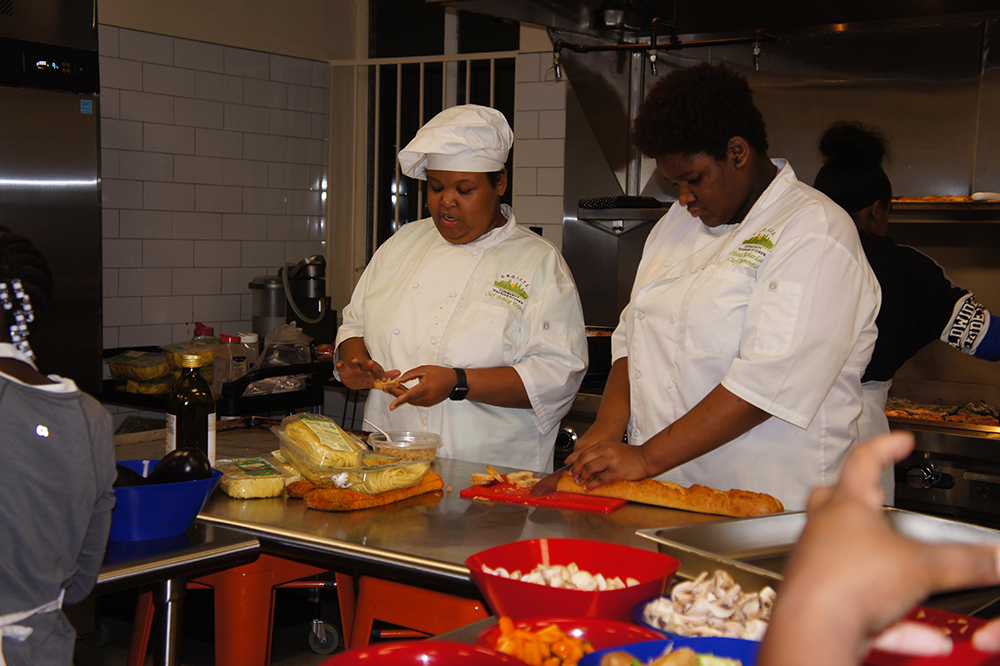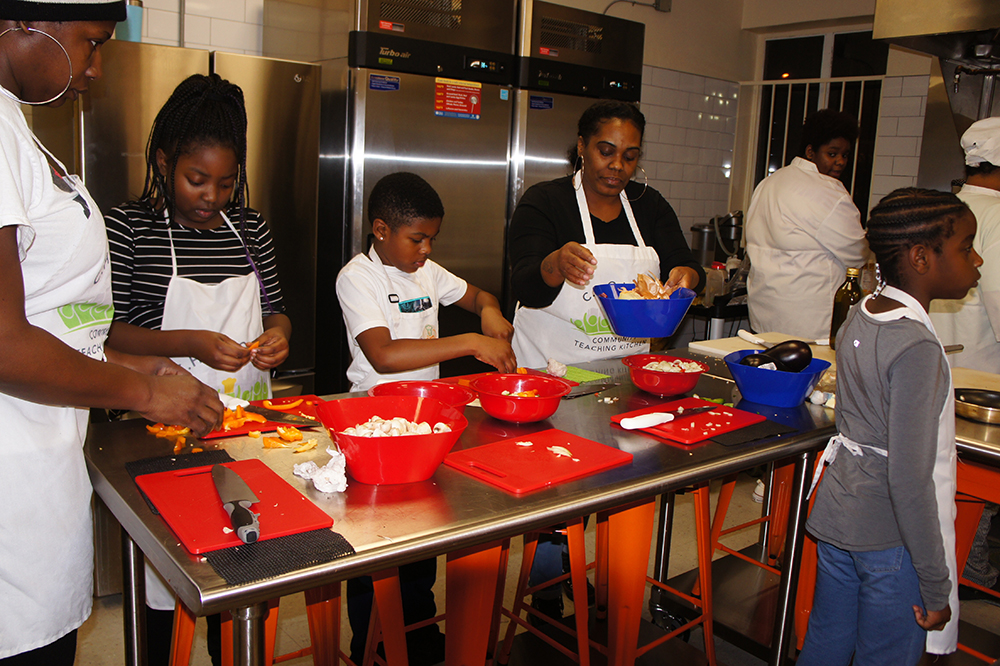
Photos by Stell Simonton
Chef Ashley Keyes and high school intern Olivia Richardson make garlic bread at the nonprofit C.H.O.I.C.E.S., which combats child obesity through cooking and nutrition education.
A tomato sauce bubbles on the stove. The aroma of baking chicken fills the air. There’s a hum of voices, a burst of laughter and a rhythmic pounding as volunteer Athena Manning flattens pieces of chicken breast with a mallet.
Chef Ashley Keyes, in her white hat and jacket, positions children and their accompanying adults at stainless steel prep tables. Several adults stand on the sidelines, poised to help.
It’s the community education kitchen at C.H.O.I.C.E.S. For Kids in downtown Atlanta. Parents and children are learning tasty, healthy and inexpensive recipes they can reproduce at home.
Although it’s a small commercial kitchen, there’s a convivial spirit — the feel of being in an African-American home kitchen in the South with friendly repartee and an appreciation for food.
C.H.O.I.C.E.S., a nonprofit devoted to ending childhood obesity, was founded in 2002 by accountant Vanetta Keys.
Keyes started the program initially as a support group when her daughter, Ashley, was young.
“There weren’t many resources available to overweight kids,” Vanetta Keys said.
Today C.H.O.I.C.E.S. functions as a resource center providing cooking classes, workshops, summer camps and health expos. Ashley Keyes, who trained at Le Cordon Bleu College of Culinary Arts in Atlanta, is executive chef. C.H.O.I.C.E.S. has a budget of $150,000, one full-time staff person and three part-time staffers.
The cooking class, held one night a week for three weeks, focuses on an inexpensive recipe that can feed a family of four.
“It allows us to teach families how to cook healthier at home,” Vanzetta Keyes said.
“If I’m cooking in the kitchen I’m cooking more vegetables and produce,” she said. In a restaurant, she said, she would be eating more sodium.
African-American and Hispanic kids are at a higher risk of obesity than the population as a whole, which in turn raises their risk of type 2 diabetes, high blood pressure and heart disease.
Gaining skills
While the kids chop onions, peppers and mushrooms, Manning, the volunteer, sears the chicken on the grill.
Manning’s daughter, Olivia Richardson, 14, an intern in the program, demonstrates how to make garlic bread with roasted garlic cloves that are soft and spreadable. She is enrolled in a culinary program at Tri-Cities High School in East Point, Ga.

Children and adults work together to make a chicken and eggplant dish at a class at C.H.O.I.C.E.S.
Cady Thomas, who turns 11 this month, is dicing peppers with her mother. “I learned how to cut onions and peppers,” she said.
When the chopping and mixing ends, the children and parents sit down in another room.
“What have you eaten this week?” Ashley asks the kids.
“Cereal,” a boy answers. “Cap’n Crunch.”
“If cereal has 9 grams of sugar or less, buy it,” she says to the group. “Do you know how much sugar is in a serving size of Cap’n Crunch?”
She sends the boy to get a box of packaged food from a table of items donated by the Atlanta Food Bank.
“This is a nutrition label. It tells you what’s in your food,” she says.
She shows the kids how to read the labels. They look at pictures of many different foods arranged under the categories “Go,” “Slow” and “Whoa,” indicating which foods are best eaten frequently vs. infrequently. They learn to use a phone app that analyzes food labels.
Then it’s time for the whole group to dine on chicken parmesan with eggplant and angel hair pasta.
The program aims to address obesity from a nutrition standpoint, Vanetta Keyes says.
To do so, it uses several ingredients.
While many after-school programs want to engage parents but find it difficult, the C.H.O.I.C.E.S. cooking class involves both parents and children. C.H.O.I.C.E.S. offers hands-on learning, presents information in an engaging way, builds career skills through internships and includes a communal meal. Parents also take home donated food items.
C.H.O.I.C.E.S. creates a positive experience while providing lots of nutrition information aimed at solving a challenging issue.





























